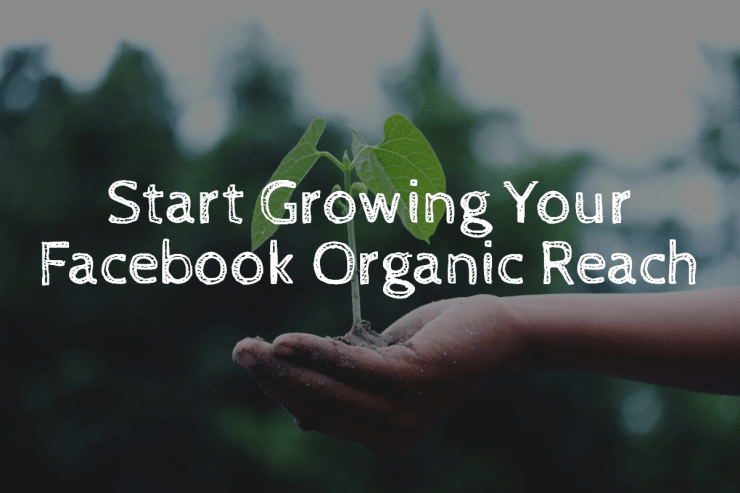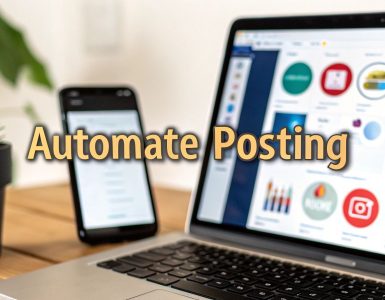Consider the following situation:
You’re posting high-quality content regularly on Facebook, you’re interacting with your followers, sharing blog posts, but for some reason, you’re not getting that high organic reach as much as you’d like.
Sounds familiar?
You seem to be hitting most check marks but you’re just not getting that juicy organic traffic in return.
Well, don’t worry, you’re not the only one going through this. The change in the Facebook algorithm has a lot of people scratching their heads
Here’s a recap:
In January 2018, Facebook announced that they were going to “shift ranking to make News Feed more about connecting with people and less about consuming media in isolation.”
So, it seems that Facebook wants you to spend more money on boosting your posts and posting ads to get through all the other content, right?
Well, not quite.
It makes sense to assume that Facebook wants you to spend your hard earned money paying for ads. But before you retire your social media content marketing efforts, you should know that there are ways you can fight back against the algorithm change.
In short, it has to do with the type of content you post and how you engage with your audiences.
You might have to switch up your approach but you can still get organic traffic from Facebook.
Here’s how:
1. Do your audience research
When it comes achieving high organic reach – you need to know what your audience is looking for.
The only way to find out what a quality post for your page looks like is to experiment and start making immediate changes.
Look within your niche to begin with. What type of posts are your competitors putting out? Videos? Infographics? Text?
Find what topics are trending within your niche through Buzzsumo and then start generating higher-quality content centered around your brand.
Content that is both meaningful, shareworthy, and relevant to your audiences. And the more specific and custom-tailored your content is for your audience – the better.
Once you get some traction going, you need the data to figure out what your audience truly likes and what they engage with best.
To do this, go to your Facebook page → More → Insights → Posts.
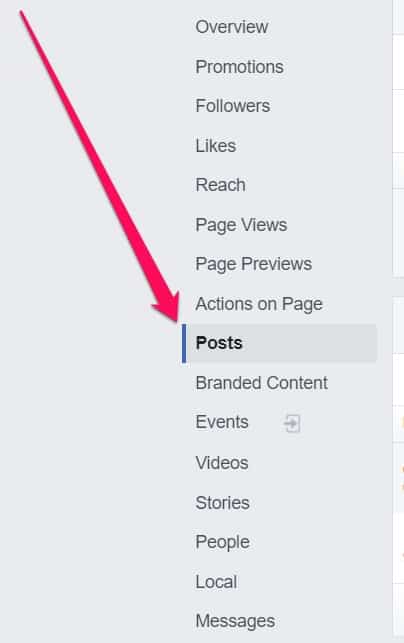
What you’re looking for here is the “Post Types” section. And there, you’ll see the performance of your most recent posts based on the data of the different posts.
When you publish new content on your page, you can post it in the form of a photo, text, link, or a video. And this report will show you which of those type of post best resonates with your audience and what they choose to engage with the most.
Because every audience is different – your results will vary.
Though, it’s worth noting that this report is only useful if you’ve been posting high-quality content consistently. If that’s not the case, your data is most likely to be skewed and this insight won’t be of much help.
But once you get in the hang of posting different types of quality content, you’ll start seeing a trend. You can then use that to shape your content calendar based on the type of posts that get more traction.
And the more you post the type of content your audience likes, the better you’ll be at generating engagement and reaching your goals through your content.
2. Quality over quantity
As mentioned above, you need quality content to start generating engagement and to increase your organic reach.
At its core, the Facebook change was to emphasize quality over quantity.
If, until now, you’ve been posting on Facebook as frequently as possible to increase your reach – you’re making things worse for yourself.
Instead, you need to take a step back and put more time in crafting the perfect post. Finding and creating quality content takes time, but it’s worth it.
Because, if you decrease your post quantity, they’ll be less likely to get lost in your audience’s feed.

Your organic reach will do much better with fewer high-quality posts than just putting them out there and hoping something sticks.
Even if you start posting content only once or twice per day at most, quality posts can still triumph.
In fact, that’s what Buffer did to 3x their reach and engagement. Here’s a quick case study.
The problem:
Buffer started receiving less organic reach and engagement despite posting ~4 times per day.
And because of the algorithm change, they were likely to continue seeing the decline in their reach.
The solution:
They changed their Facebook posting strategy and started focusing on quality over quantity.
Buffer realized that not every post was suitable for Facebook, even if the quality of the content was high.
So, they started thinking about how the posts would affect their brand awareness and cut their Facebook posting frequency by 50% to just about 1-2 posts per day.
Overall impact:
Once Buffer honed in on the quality of their posts and their general brand positioning, their average Facebook daily engagement and reach tripled.
- Reach increased from 44,000 to 150,000+ people per week.
- Average daily engagement increased from ~500 to 1,000+.
- The Facebook page grew as a result, and brought in many new likes and visitors to the site.
In short: they started hand-picking specific content (that was educational and entertaining), started curating content, changed their posting schedule, and managed to triple their engagement and reach.
The main takeaway here has to do with the quality of the posts (evergreen and original content are always good). But don’t shy away from sharing others’ posts as well. As long as it fits your brand and you don’t overdo it!
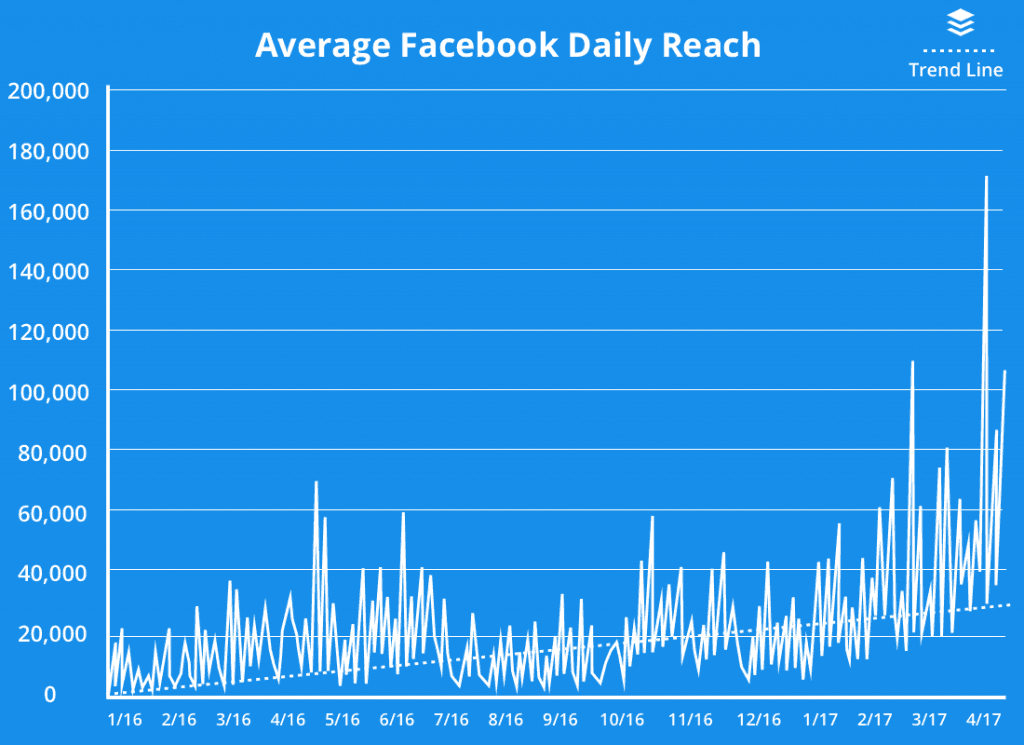
As the number of posts per day went down, the daily organic reach went up. Pic by Buffer.
Think about what you post – you can no longer get away with spray and praying content. You have to now dedicate more time to crafting a perfect post.
3. Timing matters
Finally, once you get a grasp of what type of content works and your posting schedule is full of posts, the next thing you need to think about is the timing.
What does this mean?
Essentially, you need to find out when your fans are awake and active the most (your peak engagement).
Posting at different times will bring varied results, in terms of likes, shares, etc.
So, if you schedule your posts at the right time, it’s more likely that your audience will be online to interact with it.
Once again, this is where Facebook insights shine.

More → Posts → Insights → When your fans are online.
Similarly, this also needs some experimentation with different times before you find that sweet spot.
According to a study by Hubspot, the best high engagement days are Thursdays, Fridays, Saturdays, and Sundays.
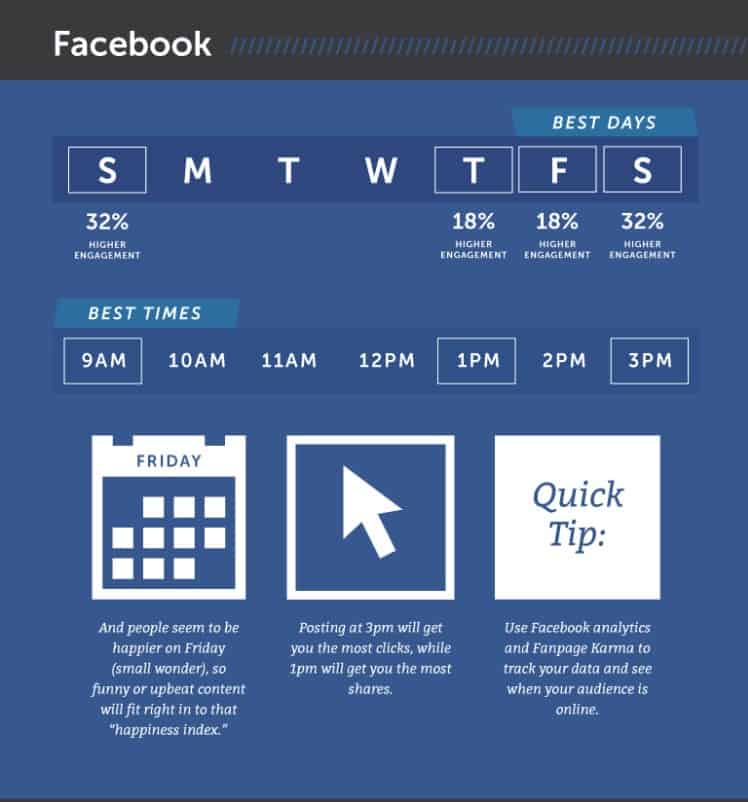
Info by Hubspot
But of course, your mileage is likely to vary, depending on your industry.
This is why clearly defining your target market beforehand is so important.
For example, if you’re targeting millennials, more specifically millennial students, then you might want to research on average when they browse Facebook the most.
Most people browse Facebook on their phones between 13:00 pm-16:00 pm. As such, their click-through rates are likely to be higher during that time as well.
Try to experiment with different timing and see how they react. Once you start sharing your content at the best times, Facebook will reward you in return.
But be sure to apply common sense as well. For example, posting during the weekend before 08:00 am or after 20:00 pm when people are asleep or out isn’t likely to get you a lot of clicks.
Bonus tip:
As I mentioned above, a lot depends on the type of content you post.
I cannot stress this enough.
It’s very easy to saturate your Facebook page with low-quality content.
So, if you’re not sure where to start – consider looking at what your competitors are doing, or start curating some content, to begin with, to see what sticks.
To save you time and headache, you can use Buffer to manage all your social media accounts in one place, EvergreenFeed to schedule your posts, and Buzzsumo to see what’s trending in your niche and what your competitors are doing.
Once you analyze what type of content works best within a niche, you’ll know what to be aiming for as a reference point.
Conclusion
Nobody knows what the future of Facebook will be like when it comes to organic reach.
But for now, you’re not the only one experiencing a decline in reaching your audience.
This is still salvageable, however.
Is Facebook’s organic reach declining as a whole? Yes.
Is it dead though? Far from it.
The tactic of throwing out content and hoping some of it sticks is no longer viable. Instead, the art requires more practice now. You might have to hand-pick some of the curated content to see if it will resonate well with your audience.
Original content, meanwhile, is, of course, always a great way to resonate with your audience.
So, start there.
Once you understand your audience well enough, you can then move on to optimizing your content and Facebook page accordingly.
While it’s hard to say what the future of social media marketing will look like, it’s safe to say that if you provide content that is a perfect fit for your audience – you’ll go far.
Finally, be sure to track your audience’s growth and use the data wisely as you grow.
Experiment with the type of content you post, draw insights from the engagement, and you’ll be well on your way to improving your Facebook organic reach.

